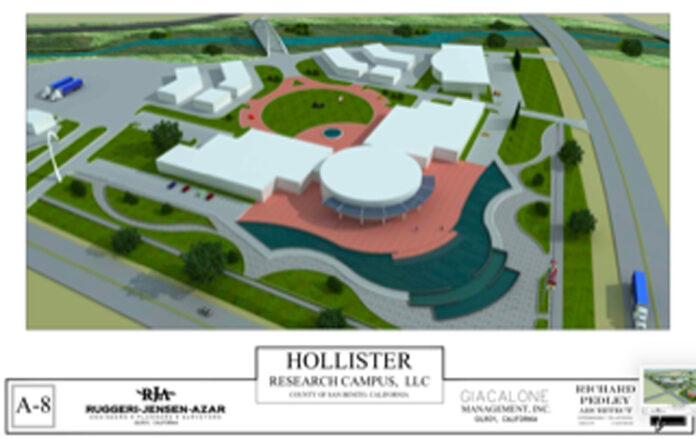
A local developer is one step closer to building the Hollister Research Campus on the north side of town. The project is proposed as a 229-acre industrial and commercial campus with an automotive testing track, two hotels, restaurants, a gas station/convenience store, a public events center and zero housing.
The property, owned by Bill Christopher, is located on the east side of San Felipe Road at the intersection of Highway 156. Developer Joe Giacalone is listed as the applicant for the Hollister Research Campus.
Before the developer can begin pulling permits, the property—a total of three parcels—must be annexed into the Hollister city limits. The Hollister City Council on Oct. 19 unanimously approved a resolution to “pre-zone” the properties and initiate a General Plan amendment to classify the properties as Industrial.
The developer still has to complete numerous additional steps before the property is annexed and construction starts. The next step is to complete an environmental study of the proposed uses, according to Victor Gomez of Pinnacle Strategy, who is representing Hollister Research Campus. The environmental study will be evaluated by the San Benito County Local Agency Formation Commission (LAFCO), which will be tasked with approving or denying the annexation proposal.
Gomez said the project has “a number of auto manufacturers interested in the site,” but he couldn’t disclose their names.
He added that concepts presented to the city so far include a 2.5-mile automotive test track and a straightaway for “testing vehicle velocity related systems in automobile technology.” The concept also includes a 20 to 25 acre “simulated city” for potential autonomous vehicle testing. But Gomez added that the project owner is not focusing exclusively on attracting the autonomous sector of auto manufacturing and research.
The Hollister Research Campus developer has submitted a plan to bring services—including water, sewer, transportation and public safety—to the site, another requirement for the annexation to be considered by LAFCO.
LAFCO also requires that the city and county draft a tax-sharing agreement for property taxes and other public revenues that will be generated by the Hollister Research Campus proposal. That agreement is in the works, Gomez told the council Oct. 19.
City Manager Brett Miller added that the new tax-sharing agreement is necessary to “make sure this area doesn’t become residential.”
Hollister Fire Chief Bob Martin del Campo told the council that public safety authorities in the region have expressed their support for the Hollister Research Campus, which could offer a venue for officers and firefighters to train for emergency vehicle operations. Currently, officers and trainees often have to travel to the Bay Area for such training.

Although the Oct. 19 council discussion included some finger pointing among the elected officials, all four council members were satisfied that the Hollister Research Campus proposal does not include any new residential construction.
“We desperately need new commercial/industrial,” Councilmember Rolan Resendiz said.
Mayor Ignacio Velazquez said the Hollister Research Campus is preferred to a proposal such as the Strada Verde development voters rejected in the Nov. 3 Measure N vote. The Hollister Research Campus property is already in an industrial zone, and the infrastructure for public services is already in place, Velazquez said.
Velazquez added that because the Christopher properties are closer to town, the Hollister Research Campus doesn’t threaten to create the kind of “master plan community” that some feared from Measure N.
“We want people as close to town as possible, and not creating more traffic,” Velazquez said.









